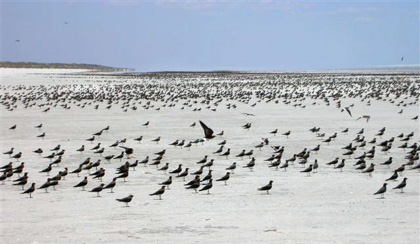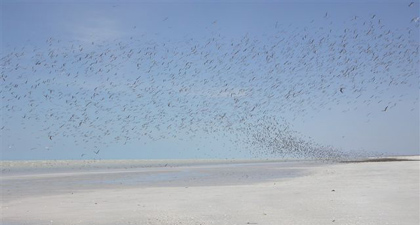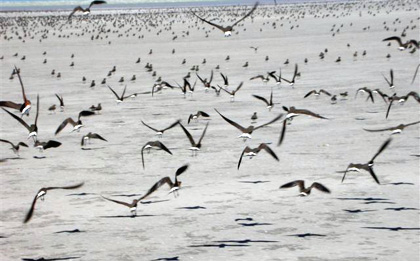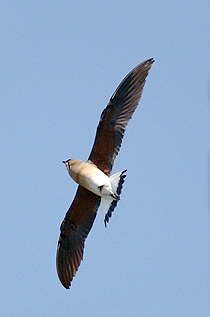
I was a member of the Australasian Wader Study Group's expedition to north west Australia from January 24th to February 14th 2004. While on the expedition we made the discovery of unprecedented numbers of Oriental Pratincoles Glareola maldivarum on Anna Plains Station and the entire length of Eighty Mile Beach.
I drove from Perth to Broome for the expedition, with the final leg from Port Hedland to Broome on Tuesday 20th January. I saw no pratincoles on the journey to Broome. The next day I visited the Crab Creek mangroves where I saw a flock of about 5,000 Oriental Pratincoles lifting off the mud flats as the tide approached. I thought at the time that it was unusual that they had been roosting on the mud flats. They were there for several more days. I have seen flocks of this size in Broome before, but only over the grasslands of Roebuck Bay Station. I drove to Derby for the day on the Thursday. I saw no pratincoles on this trip, including at the Derby airport where I had previously seen a flock of 10,000. So I had no reason to expect what we found when the AWSG expedition drove to Anna Plains Station on Monday 2nd February.
We started seeing Oriental Pratincoles about 50km north of Anna Plains Station flying low over the scrub. They weren't large numbers (up to 50), but enough for people to comment about them being there and about them flying low. We continued to see small groups as we drove to the station. Several large flocks of Oriental Pratincoles flew past close to the homestead from the scrub west out over the plain. The largest flock was at least 1,000. In the afternoon people reconnoitred several potential mist netting sites on the plain.
We saw 'smokes' of many thousand Oriental Pratincoles and one group saw very large numbers low over the plain close to dusk. The numbers were so high that a decision was made at the meeting that evening to set mist nets and cannon nets on the plain the following evening. Normally you would think that this was like looking for a needle in a haystack.
We made our first cannon net catch on Eighty Mile Beach the next day (Tuesday) 2km north of the Anna Plains Station entrance. We saw a few Oriental Pratincoles on the beach. As planned, we set a line of mist nets and two cannon nets on the plain in the late afternoon. The pratincoles were in large numbers over the plain (flocks of 1,000s to 10,000+), but those close to the mist nets almost all flew parallel to the nets. Seven birds were caught in daylight and eight more in the fading light after sunset. The AWSG had only caught about 200 Oriental Pratincoles in the past, and never before by mist net.

We cannon netted on Wednesday morning 5km south of the Anna Plains Station entrance and there were good numbers of Oriental Pratincoles on the beach prior to the catch. We normally aim for a catch of about 150 to 200 birds, but because the AWSG only had very limited data on Oriental Pratincoles, we fired when we only had about 30 Oriental Pratincoles in front of the net. We cleared the net quickly, and fired the second net catching another 60+ Oriental Pratincoles. As we drove back along the beach after the catch we began to realise that we were witnessing something very unusual. The informal estimates of Oriental Pratincoles roosting on the mud flats along the 5km stretch varied from 100,000 to 250,000. My estimate was 180,000 +/- 50,000. They far outnumbered the 'grey waders'. This generated some discussion at the evening meeting, and there was agreement that we had to make an estimate of the numbers of Oriental Pratincoles. The possibility of an aerial count of the full beach was floated.
On Thursday 5th February the cannon netting site was 9km south of the Anna Plains Station entrance. When we arrived at the beach it was clear that the numbers of Oriental Pratincoles had increased. We caught a further 120 Oriental Pratincoles between the two nets that we fired. After the catch, one vehicle went to investigate the Oriental Pratincoles. They found several hundred thousand including 46,000 in the southern most kilometre, and similar numbers could be seen in the distance to the south. There was considerable discussion at the meeting that night and a decision was made to do a count of the northern most 71km of Eighty Mile Beach accessible from Anna Plains Station after the cannon net catch the following day.
On Friday 6th February the cannon netting site was 16km south of the Anna Plains entrance (or 4km north of the Fisherman's Camp entrance which was the way we travelled). There were again very large numbers of Oriental Pratincoles along the beach far outnumbering the 'grey waders'. By now we were falling behind our targets for the 'grey wader' species, so we passed up opportunities to catch Oriental Pratincoles. After the catch was processed, the beach was divided into three sections and a vehicle was sent to each section with 3 to 6 people to count the Oriental Pratincoles. The northern vehicle went north of Cape Missiessy for a further 15km, so a total of 86km of beach was counted. The total was an incredible 818,000. We have good reason to believe this count is reasonably accurate (maybe within 10%), as the people in each car had to agree on the count of each flock as they went. The heaviest concentrations were again at the southern end of the beach. If the 818,000 was extrapolated along the full length of Eighty Mile Beach, the total number could be as high as 4 million Oriental Pratincoles.
Friday also saw the possibility of an aerial count come to fruition. Clive Minton (the expedition leader) had mentioned the idea to John Stoate, the owner of Anna Plains Station. John knew of a pilot who would make the flight for free, if we could charter an aircraft that was available. Clive contacted Grant Pearson from CALM in Perth, and Grant along with Allan Gross agreed that CALM would pay for the flight. The flight was scheduled for just after high tide on the following day.
Three experienced wader counters made the flight on Saturday 7th February. Peter Collins counted the birds on the southward flight. Humphrey Sitters counted the birds on the northern flight. Brian Etheridge was the recorder. Peter's count was 2.45 million, and Humphrey's count was 2.88 million. There was considerable thought given about reasons for the difference in the counts, and about how accurate the counts were. There were good reasons to believe that both counts were reasonably accurate, with the first count being augmented by the continued arrival of birds from the north and inland, and that the counts were more likely to be conservative than overestimated. The vast majority of birds in both counts were around the mouths of several creeks on Mandora Station where the sands and mud flats were much wider than anywhere else. The full details of the events and counts are soon to be published in the International Wader Study Group Bulletin (Sitters et al. 2004).
I left Broome on Sunday 15th February to return to Perth. I started to see Oriental Pratincoles in small numbers near Pardoo Roadhouse and I saw the last on the following day near Whim Creek. The biggest numbers totalling almost 45,000 Oriental Pratincoles were near South Hedland flying over grass and spinifex plains and acacia scrub. The largest flock was about 20,000. This was in stark contrast to when I had driven north.

What is the significance of this count? Firstly, the accepted number of Oriental Pratincoles in the Australasian East Asian Flyway prior to our discovery was only 75,000 (Bamford et al. 2003). We subsequently learnt of an unpublished report of nearly 400,000 in April 1975 by John Darnell near Mount Blaze in the Pilbara. So our count was 7 times higher than any previous count. Second, the most common migratory shorebird in the flyway was previously thought to be the Red-necked Stint with about 800,000.
Why were they at Anna Plains Station and Eighty Mile Beach? And why had they never been recorded in these numbers before? We asked ourselves these questions while we were at Anna Plains Station. The conditions were excellent. There had been good rains just before New Year, which led to the plain having a generally good cover of grass, but there had been little follow up rain until a couple of days before we arrived, so the grass was not very high or dense. There were large numbers (but not plague proportions) of Yellow-winged Locusts Gastrimargus musicus. The pratincoles appeared to be feeding on the locusts. We never saw one catch a locust, but we could feel them in the crops of some of the pratincoles we caught, and the beach also had a lot of wings from the locusts, which we felt must have been discarded by the pratincoles while they were roosting on the mud flats.
Pratincoles are largely considered to be crepuscular feeders feeding mostly early in the morning and late in the afternoon, possibly even after sunset when there is a full moon (McNeil et al. 1992). The days became increasingly hotter during the week leading up to the aerial survey. We felt that the pratincoles were feeding in the morning until it became too hot, and then flew out to Eighty Mile Beach to rest during the hottest part of the day, before returning inland in the late afternoon to feed again and to roost. We have seen this on previous expeditions with Oriental Plovers.
The biggest clue came when someone read the species account in the Handbook of Australian, New Zealand and Antarctic Birds (HANZAB) (Higgins & Davies 1996) which indicated that Oriental Pratincoles may move into an area after rainfall, but that they may leave after persistent heavy rain. They followed this up by contacting the Australian Government Bureau of Meteorology who provided a rainfall map for the three months prior to our sighting. The area from the Gulf of Carpentaria west to the east Kimberleys were mostly well above the annual average. But the west Kimberley and the eastern Pilbara were well below average. Oriental Pratincoles are presumably spread most years across the grasslands of western Queensland and the Northern Territory.
As predicted by HANZAB, we concluded that they had been pushed west by the excessive rainfall in most areas of their normal distribution. These areas are largely inaccessible, especially in the wet season, and we conclude that either much of the population does not normally migrate all the way to Australia (perhaps remaining spread out across Indonesia or the Phillippines) and that noone has been there at the right time to count them, or that they do usually migrate in these numbers to Australia but that conditions have never been so favourable to make them congregate together in such large numbers. We were in the right place at the right time to witness the event. If we had been there a week later when the birds had moved further south, we would have missed the event. A week earlier and the birds would not have yet arrived.
Thanks to Chris Hassell for permission to use his images:
email: turnstone@wn.com.au
turnstonenaturediscovery.com.au

© Kim Hyun tae.
Considered a rare migrant by Lee, Koo and Park (2000), the Oriental Pratincole Glareola maldivarum is a fairly scarce migrant in South Korea, recorded most often in late April and early May on west coast islands, and occasionally in extensive rice-field areas on the west coast (especially Seosan). Records appear to be increasing, though this could well be as much a product of improved coverage as a genuine increase in numbers. In North Korea, Tomek (1999) lists only a single, old record (that from October 1931), while Brazil (1990) states that in Japan the species was previously considered an accidental with only ten records in the first half of last century. However, in recent decades it has increased, with local breeding now recorded in western Japan and the Nansei Shoto. Considering that breeding has occurred in Fukuoka (in the mid-1990s at least), only 200 km south of the peninsula, it seems possible that breeding will be recorded here too in future years, perhaps in a recently-reclaimed area. (NB: it's worth noting in this regard that another 'Asian-mainland' shorebird, the Black-winged Stilt Himantopus himantopus began breeding in Japan in 1975, and then in South Korea from 1998).
Elsewhere on the East Asian-Australasian Flyway (a flyway stretching from Australasia in the south to northern Siberia and western Alaska to the north), the total population of Oriental Pratincole had been estimated at 75 000 individuals - based principally on boreal winter and spring counts in Australia with lesser numbers recorded west to India and east to Viet Nam - out of an estimated total of ca 6 million migratory shorebirds on the flyway as a whole. This record count of almost 3 MILLION Oriental Pratincole made by Frank O'Connor, Chris Hassell, Dr. Clive Minton and others in February 2004 therefore greatly alters our understanding of its abundance (it becomes the commonest, or certainly one of the commonest shorebirds on the flyway, helping explain perhaps why it has occurred as a vagrant both in western Europe and in North America). In addition, it also means happily that the estimated total number of shorebirds of all species using the flyway needs to be upwardly revised - to at least 8 or even 9 million individuals.
Even more happily, it suggests that even while the majority of shorebird species worldwide appear to be in decline, this amazing count offers hope that a few species might still remain significantly more numerous than presently feared…
References
- Brazil, M. (1991). The Birds of Japan. Helm, London.
- Lee, W., Koo, T. & J-Y Park.(2000). A Field Guide To the Birds of South Korea. Evergreen Foundation.
- Tomek , T. (1999). The birds of North Korea. Non-Passeriformes. Acta zool.cracov. 42 (1): 1-217.



